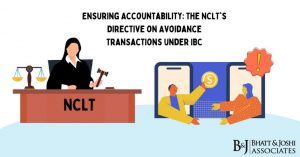TRANSITION OF LAWS FROM SICA TO IBC
TRANSITION OF LAWS FROM SICA TO IBC
Introduction
The name Sick Industrial Companies Act itself connotes the reason for its existence. In the 1980s, India saw a wave of widespread industrial sickness, prompting the government to pass important legislation to address the problem. The SICA was adopted in 1985 with the goal of ensuring the timely detection of sick and potentially sick firms that own industrial undertakings, as well as the quick assessment by a panel of experts of the preventative, corrective, and other measures that must be done in their case. This was an action to free up investment in such industrial facilities that had been locked up and put to better use.
The Insolvency and Bankruptcy Code of 2016 is a legislation that consolidates and modifies the legislation governing reorganisation and insolvency resolution of Corporate Persons, Partnership Firms, Limited Liability Partnership and Individuals in a time-bound manner, for the purpose of maximising the value of such persons’ assets, promoting entrepreneurship, increasing credit availability, and balancing the interests of all stakeholders, including changing the order of priority of payment of Government dues, and establishing an insolvency and Bankruptcy Board of India, and for matters connected with or incidental thereto. 
PROBLEMS WITH SICA
The SICA’s main limitation was that it only applied to sick industrial enterprises, excluding enterprises engaged in trading, service, or other operations. However, the whole experience was unsatisfactory due to a number of variables, including SICA’s inapplicability to non-industrial and small/ancillary businesses. The Sick Industrial Companies (Special Provisions) Act was abolished and replaced by the Sick Industrial Companies (Special Provisions) Act of 2003, which diluted some of SICA’s provisions and filled in some loopholes. One of the most significant modifications in the new law was that it attempted to decrease the growing prevalence of occupational disorders by guaranteeing that firms do not utilise a medical certificate to avoid legal duties. The other reasons why SICA fell short are:
- The scope of SICA was defined by the terms “sickness” and “industrial nature.” Since the passage of SICA, there has been a discussion about the meaning and breadth of the term “sick industries” and what happens if a business that has been referred to BIFR and is currently under moratorium loses its industrial nature. Even after the Code’s enactment and repeal, the question remained unsolved.
- Only the Board of Directors, the Central Government, the RBI, state-level agencies, or scheduled banks might recommend a company to SICA. If a creditor is not a scheduled bank or just a vendor with a large quantity of past due payments, he or she cannot file for insolvency.
- The SICA did not set any deadlines for the BIFR to complete its investigation and issue an order requiring an operating agency to prepare a rehabilitation plan. Only once such an order was passed were deadlines set.
- There was inadequate oversight of companies who exploited SICA to implement a moratorium and dodge lenders and the Board of Directors could utilise it for its own purposes. SICA gives the company an advantage over lenders because other lenders will be unable to pursue the company if it is referred to BIFR.
- It was up to the discretion of the BIFR to appoint an operating agency for the sick industrial company referred to it, only in suitable cases. As a result, the SICA system was not standardised, and it did not guarantee that a company’s rehabilitation would be carried out in a prescribed manner.
Development of IBC
The Code is significantly influenced by other jurisdictions and was written to address the numerous flaws that existed in previous processes for corporate reconstruction and rehabilitation. The code in comparison is much simpler and effective as it involves an integrated “Corporate insolvency resolution process”. Upon default, any financial creditor, operational creditor, or the corporate debtor itself may file an application with the National Company Law Tribunal [“NCLT”) to begin the insolvency resolution process. The NCLT may accept the application if the existence of a default and non-payment of dues by the defaulter is established. The following elements of the Code make it a successful instrument for a company’s rehabilitation:
- Lenders participate actively in the decision-making process as members of a “committee of creditors.” Lenders also have the authority to determine which investment plans are acceptable. Under the SICA, the BIFR was in charge of receiving and deciding on creditors’ comments and objections. With the involvement of lenders, such commercial decisions become easier, and all stakeholders have a clear stake in the company’s recovery.
- The activities and routine business are continued and handled by the resolution professional with prior consent from the committee of creditors, despite the moratorium prohibiting any action by creditors or anyone against the defaulting company. As a result, the company is preserved as a going concern.
- For all parties involved in insolvency procedures, the Code has established distinct levels of accountability and responsibility. As a result, the creditors’ committee is responsible for the resolution professional’s activities and vice versa. In addition, the resolution professional must provide regular progress reports to the NCLTs to keep them informed of the insolvency’s progress.
- From the beginning to the finish of the procedure, timelines have been established. The entire insolvency resolution procedure is limited to 180 days; however it can be extended to 270 days if necessary thus making it a strictly time bound process.
Conclusion
Any corporate body, whether through service or sale agreements, loans from banks and financial institutions, judgments, or even interactions with the government, incurs a variety of obligations while operating. A corporate entity’s debt load can sometimes become so high that it endangers its continued existence and operation, while creditors risk losing their whole investment. It should be emphasised that a business’s liquidation or wind-up, as an alternative to insolvency procedures, would result in a complete wrap-up of the firm in such a way that it would no longer exist. When compared to insolvency processes, wind-up processes cause the economy to suffer a bigger loss. Therefore, The Code has revolutionized the process of insolvency resolution in India. IBC is, without a doubt, a comprehensive law with a swift and precise mechanism for dealing with insolvency issues. The time-bound aspect of IBC is a win-win situation since the Companies’ resources are deployed in the appropriate place at the appropriate time, whether it’s by paying creditors or winding up. The company does not continue to lose money indefinitely, inflicting a setback to the economy as whole and impacting individual debtors. Thus, the Code has established a new and improved framework for corporate insolvency resolution, which is far superior to the SICA regime.
Author: Aaditya Sharma
Editor: Adv. Aditya Bhatt & Adv. Chandni Joshi









